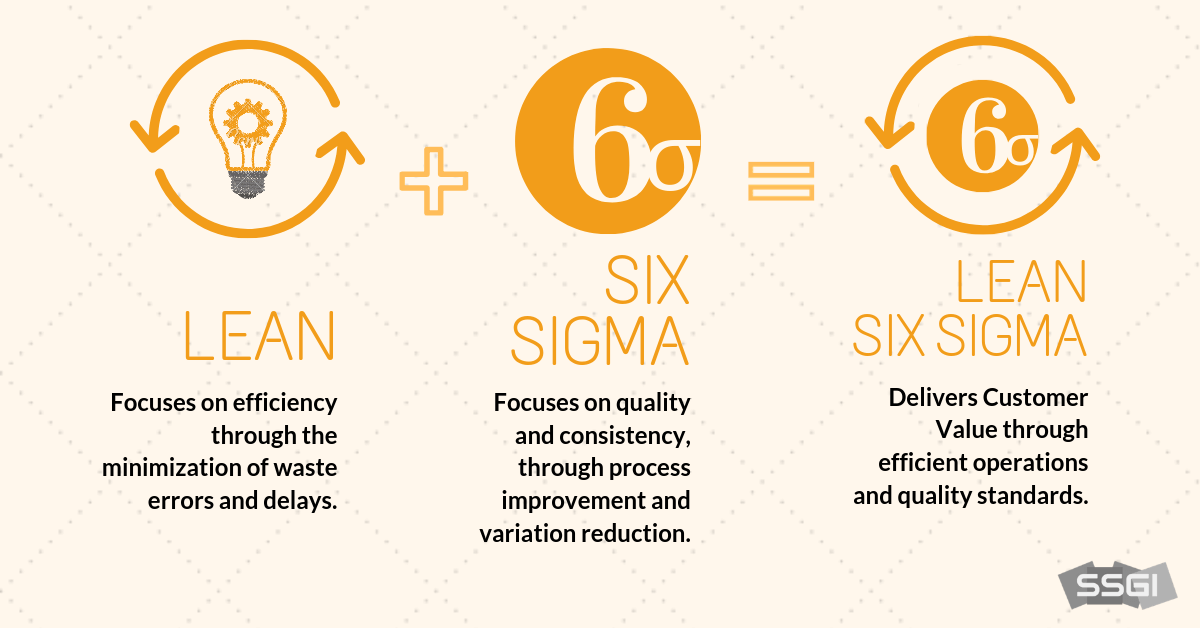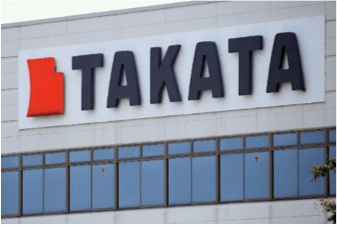Lean Six Sigma vs Six Sigma?
A great question that’s frequently asked is, “what’s the difference between Lean Six Sigma and Six Sigma?” Or “is Lean Six Sigma and Six Sigma the same?”
To better make sense of this question, we first must understand that there are 3 main methodologies, which include: Lean, Six Sigma and Lean Six Sigma.

Each methodology has its own differences, applications and benefits. Below we will dive into each methodology and explain how they differ from one other so that you can develop a complete understanding of Lean vs Six Sigma. Through this you will understand how these methodologies improve business processes, reduce waste and defects, and enhance efficiency and quality.
Is Lean and Six Sigma the same?
Understanding The Difference Between Lean and Six Sigma
The main difference between Lean and Six Sigma is that Lean focuses on efficiency through the reduction of waste. While Six Sigma focuses on quality through the reduction of errors.
Lean Six Sigma combines these two concepts, which in return allows organizations to provide higher quality products and services delivered through efficient operational processess. This results in enhanced customer satisfaction and improvements to the organizations bottom line.
Core Principles of Six Sigma
- Works to optimize the organization through data.
- Decreases variation.
- Six Sigma makes a product or service more effective.
Core Principles of Lean Six Sigma
- Lean tools are used for improving efficiency by increasing value and reducing waste.
- Determines value from the customers perspective.
- Lean focuses on end-to-end improvement and optimizing process flow.
What is Lean?
Lean is very different from Six Sigma.
Lean is concerned with efficiency. It focuses on how operational processes are designed and managed to minimize inefficiencies that can be attributed to the following.
- Delays
- Errors
- Waste
 Lean Case Study Example
Lean Case Study Example
Consider the challenges faced by the crew, staff and vendors of Royal Caribbean Cruise lines when the Symphony of the Seas docks early AM on Saturday mornings at the Port of Miami. Between 9AM and 4PM nearly 7,000 passengers depart the ship and another 7,000 board. While this is a challenge by itself, consider what goes on behind the scenes. More than 20,000 pieces of luggage must be moved, 2,759 staterooms cleaned, trash unloaded, and food supplies replenished. This carefully orchestrated process leaves no room for delays, errors or waste. Every step must be efficient. Or, to say this another way, the turnaround process must be Lean.
There are so many other situations where process efficiency is key to delivering customer value. Emergency departments at hospitals must be designed to minimize delays so patients can be seen soon after they arrive. On-line retailers must design logistics processes to minimize order processing delays and, in many cases, to deliver in one day, and manufacturing operations must be designed to minimize the waste associated with unnecessary process steps.
Lean Methodologies and Tools
Value Stream Mapping, 5S, and Kaizen.
What is Six Sigma?
Six Sigma is a data-driven approach focused on eliminating defects in any process. Whether it be manufacturing or logistics, Six Sigma can improve the quality and consistence of products and services. It does this by identifying and removing the root-causes of defects and ensuring the lowest amount of variability in business processes. It achieves this through a set of quality management tools and statistical methods.
Six Sigma focuses on:
- Quality
- Consistency
By consistency we mean delivering products and services that day-after-day meet quality standards; the product we deliver today is just like the one that is delivered tomorrow.
When we eat a restaurant, purchase a new hard drive, or travel on an airplane, we expect a certain level of quality. The role of Six Sigma is to ensure that this level of quality is delivered to the customer.
Six Sigma Case Study Example
Sometimes, companies fail to meet this challenge.
 Takata a Japanese manufacturer of auto airbags is one such example. These airbags relied on a compound of ammonium nitrate that expands upon impact, inflates the bag, and thereby protects the driver and passenger from head or body injuries.
Takata a Japanese manufacturer of auto airbags is one such example. These airbags relied on a compound of ammonium nitrate that expands upon impact, inflates the bag, and thereby protects the driver and passenger from head or body injuries.
However, the compound broke down when exposed to moisture and temperature swings. Some accidentally exploded sending metal fragments though the passenger compartment. In total 19 auto manufacturers recalled approximately 37 million vehicles in which over 50 million airbags were replaced. It was the largest recall in automotive history. Moreover, the human toll was substantial. Twelve people died and almost 200 were injured.
 Then there were the Boeing Max 8 disasters when two aircraft, within six months of each other, crashed shortly after takeoff. In total, 346 people died. The problem was traced to software problems in the Maneuvering Characteristics Augmentation System (MCAS). As part of the auto pilot system, the MCAS prevented the pilots from overriding the system and recovering from the steep descent. They tried to overcome the system controls but failed.
Then there were the Boeing Max 8 disasters when two aircraft, within six months of each other, crashed shortly after takeoff. In total, 346 people died. The problem was traced to software problems in the Maneuvering Characteristics Augmentation System (MCAS). As part of the auto pilot system, the MCAS prevented the pilots from overriding the system and recovering from the steep descent. They tried to overcome the system controls but failed.
While the Takeda and Boeing failures reached headline status, there are countless stories of quality failure, less known, but nonetheless underscoring the challenge that organizations face to assure their products and services meet quality standards.
The job of Six Sigma is to prevent these failures by instituting effective quality control processes at the manufacturing or service level before it’s too late.
This, then, is the difference between Lean and Six Sigma. Lean focuses on efficiency while Six Sigma focuses on quality. Both are essential to support sustained competitive positions in an industry.
Six Sigma Methodologies and Tools
DMAIC (Define, Measure, Analyze, Improve, Control), statistical analysis, and control charts.
What is Lean Six Sigma?
Lean Six Sigma serves as a hybrid approach that combines the best of Six Sigma (quality and consistency) with the best of Lean (efficiency) to help organizations deliver customer value through efficient operations and quality standards, which results in creating higher quality products and services. Because it’s approach tackles both issues, Lean Six Sigma has become the most popular methodology in industry. From healthcare to government agencies, Lean Six Sigma is can be applied to almost any industry and any job function.
The benefits of Lean Six Sigma are widespread. These benefits help organizations to:
- Increase Profits
- Decrease Costs
- Improve Efficiency & Quality
- Improve Customer Satisfaction
- Enhance Employee Development
How Lean Six Sigma improves business processes?
Lean Six Sigma improves business processes through reducing waste and defects, and enhancing efficiency and quality.
Lean Six Sigma methodologies improve business processes by integrating Lean’s focus on eliminating waste (non-value-added activities) with Six Sigma’s emphasis on reducing defects and variability. This dual approach streamlines operations, enhances quality, and improves efficiency by systematically identifying inefficiencies, analyzing data to find root causes of problems, and implementing solutions. The result is a more agile, cost-effective, and customer-focused operation that consistently delivers high-quality products or services.
Is lean six sigma outdated?
You might be wondering, is lean six sigma outdated? Absolutely not, if anything it is more applicable now than ever as more organizations value the principles of efficient and effective operations. From projects to manufacturing to customer support, the methodologies of Lean Six Sigma play a critical role in ensuring operational efficiency, which is now the golden standard for almost every organization no matter the industry. Remember, effecincy and quality = Lean Six Sigma!
Lean Six Sigma Certification Belts
Which lean six sigma certification is best?
Certification in Lean Six Sigma as well as Six Sigma is broken down (beginner to advanced) into different belts. These belts indicate various levels based on expertise, experience and pre-existing knowledge. To determine which lean six sigma certification is best for you, first you must understand the associated belt levels.
The Lean Six Sigma Certification belts include:
Learn more about which Six Sigma Belt is right for you.
Should I do Lean or Six Sigma first?
Because Lean Six Sigma is a hybrid of both Lean and Six Sigma, the material covered in a Lean Six Sigma certification program generally covers everything that is also covered in a standard Six Sigma program. The only difference is that there is additional coverage of Lean in the material.
All three methodologies are designed to help organizations become more competitive in the marketplace. Those with knowledge in Lean, Six Sigma and Lean Six Sigma are in a position to add sustainable value and take a lead role on implementing process improvement initiatives. Competitive organizations value the concepts associated with Lean Six Sigma, which is why we recommend you first take a Lean Six Sigma program to get full coverage.
If you are interested in becoming certified, check out Six Sigma Global Institute for more information on Lean Six Sigma certification and training.

